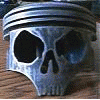Twins on an inline, 1.3L engine is ridiculous. You went from 4 firing events per turbo every 720 degrees, to just two, effectively killing manifold pressure. It would take longer to build boost since exhaust isn't a steady pressure, it's a pulse generated by rising pistons. once that valve closes, pressure drops untill then next valve opens, piston starts to rise. If you take that from 4 pulses per 2 revoloutions, to 2, your only getting a single pressure wave with every rotation of the engine. Not to mention using a turbo small enough, with a small enough turbine/housing to make it work, would leave very little drive to spin an even half way decent compressor wheel. Especially on a motor that spins to 11k, your going to expect such a small turbo to work over such a broad RPM range it just isn't going to be much fun to drive. Lag would be a bitch, and it would come in very fast, and abrupt, and max out well before redline. Most twin setups are that way because of a "V" motor, and yes, it keeps the manifold short and hot, and minimizes lag. Also on a motor over 5.0 liters, it breaks it up so you can have a more streetable engine. boost would come in smoother and at a lower RPM, with less exhaust restriction using a pair of med sized turbos, VS 1 large frame turbo. If anyone is seriously interested, theirs a book called "Maximum Boost" by Corkey Bell that is an excellent resource for Turbo information, both setup and theory


